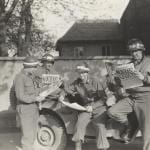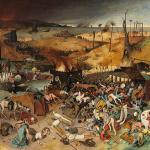An important new book explores the intersection between politics, religion, and media in modern US history. It’s going to have a major impact.
Paul Matzko is a former doctoral student of mine at Penn State. His book, from Oxford University Press, is titled The Radio Right: How a Band of Broadcasters Took on the Federal Government and Built the Modern Conservative Movement. He began researching the world of conservative and far Right religious broadcasters between the 1940s and 1960s, radio preachers like Carl McIntire and Billy James Hargis. The sheer scale of those Radio Right media empires in the 195os and early 1960s was amazing, in particular the mass audiences they could stir up for local activism and boycott campaigns. The preachers had galvanized and were directing a whole national movement of radical Right anti-Communist populism, explicitly grounded in fundamentalist religion. Paul was making major finds about the prehistory of the Religious Right as it emerged to public view in the 1970s, the world of Jerry Falwell and the Moral Majority.
But beyond this, Paul also made some startling archival discoveries, showing how aggressively the White House had tried to suppress those activists, in an astonishing exercise of government power against an unpopular form of religious expression. The whole story throws a new and unsettling light on the Kennedy and Johnson administrations – and indeed, shows how these precedents gave Richard Nixon ideas for how he wanted to control and penalize hostile media.
The religious aspect is critical throughout. After reading Paul’s book, you have a much better idea of the activities of the religious Right in this era, and the extreme fundamentalists. But The Radio Right is also very informative on the liberal response, and the National Council of Churches.
If you want to understand the mindset of the government at this time, recall the febrile atmosphere surrounding alleged far-Right plots, popular militias, and even threats of coup d’etat, which became such a powerful theme of mainstream political thought between 1961 and 1964. In 1962, Charles W. Bailey II and Fletcher Knebel had published the genuinely exciting military coup novel Seven Days in May, which was a spectacular bestseller in the months following the Cuban Missile Crisis, and which became one of the major films of 1964. That same year brought Dr. Strangelove, in which a deranged far Right military commander named Jack D. Ripper starts the Third World War. Wild and wonderful conspiracy theories were already a very familiar part of American political discourse long before the assassination of JFK.
Central to all this was far-Right general Edwin A. Walker, who was forced into resigning in 1961 after undertaking extremist propaganda among his troops, and openly attacking the government as pink. He later became a focus of Rightist dreams of a military takeover: in November 1961, JFK denounced conservatives as those who “look suspiciously at their neighbors and their leaders” and who “call for ‘a man on horseback’ because they do not trust the people.” Nobody doubted who he was thinking of. Walker was a major inspiration for Seven Days in May, and he is the direct origin of Strangelove‘s Jack D. Ripper.
Walker even features indirectly in the JFK story. I quote Wikipedia:
During February 1963, Walker joined Billy Hargis in an anti-Communist tour named “Operation Midnight Ride”. In a speech Walker made on March 5, reported in the Dallas Times Herald, he called on the United States military to “liquidate the [Communist] scourge that has descended upon the island of Cuba.” Seven days later, Lee Harvey Oswald ordered by mail a Carcano rifle, using the alias “A. Hidell.”
Reputedly, that April, Oswald then tried to assassinate Walker at this home in Dallas. (Sooner or later, so much of this stuff comes back to Texas!) I also note that in the context of 1963, a peak of Ku Klux Klan terrorist violence, calling something Operation Midnight Ride was beyond provocative.
In those various coup scenarios, the fundamentalist religious Right was regularly depicted as providing the ideological framework for extremism, and from the point of view of the White House and of liberal media outlets, propagandists like Hargis and McIntire were an integral part of that Seven Days in May scenario. Apparently, listening to Hargis had been a key factor in Edwin Walker’s decision to come out publicly in opposition to the government over desegregation. Pulling these threads together, Lee Roy Chapman had a great write up on Walker entitled “The Strange Love of Dr. Billy James Hargis.” Reinforcing that religious element was the booming John Birch Society, which took its name from an American Baptist missionary murdered by Chinese Communists. Rightly or wrongly, liberals were taking the far Right religious threat very seriously indeed. These were scary times.
Just as a sidebar: has anyone ever written a history of the Seven Days in May motif in modern American political history? I know the phrase came back full force in 1973-74, when the Pentagon was found to be running a genuine spy ring within the Nixon White House. In 1983, the Soviets turned the original novel into a TV miniseries called The Last Argument of Kings, as part of their anti-Reagan propaganda. But that’s another story.
Yes, I’m biased, but I think Paul Matzko’s The Radio Right is a superlative piece of history, very well written and thoroughly researched. I don’t think you can understand the whole development of the modern”Christian Right” without it.
Let me quote the book’s description:
In the past few years, trust in traditional media has reached new lows. Many Americans disbelieve what they hear from the “mainstream media,” and have turned to getting information from media echo chambers which are reflective of a single party or ideology. In this book, Paul Matzko reveals that this is not the first such moment in modern American history.
The Radio Right tells the story of the 1960s far Right, who were frustrated by what they perceived to be liberal bias in the national media, particularly the media’s sycophantic relationship with the John F. Kennedy administration. These people turned for news and commentary to a resurgent form of ultra-conservative mass media: radio. As networks shifted their resources to television, radio increasingly became the preserve of cash-strapped, independent station owners who were willing to air the hundreds of new right-wing programs that sprang up in the late 1950s and 1960s. By the early 1960s, millions of Americans listened each week to conservative broadcasters, the most prominent of which were clergy or lay broadcasters from across the religious spectrum, including Carl McIntire, Billy James Hargis, and Clarence Manion. Though divided by theology, these speakers were united by their distrust of political and theological liberalism and their antipathy towards JFK. The political influence of the new Radio Right quickly became apparent as the broadcasters attacked the Kennedy administration’s policies and encouraged grassroots conservative activism on a massive scale.
Matzko relates how, by 1963, Kennedy was so alarmed by the rise of the Radio Right that he ordered the Internal Revenue Service and Federal Communications Commission to target conservative broadcasters with tax audits and enhanced regulatory scrutiny via the Fairness Doctrine. Right-wing broadcasters lost hundreds of stations and millions of listeners. Not until the deregulation of the airwaves under the Carter and Reagan administrations would right-wing radio regain its former prominence. The Radio Right provides the essential pre-history for the last four decades of conservative activism, as well as the historical context for current issues of political bias and censorship in the media.
Here are recommendations from some academic heavy hitters:
“Challenging the conventional wisdom of 1960s political history, The Radio Right not only shows how far-right broadcasters laid the grassroots groundwork for modern conservatism but also chronicles how the liberal establishment–from the Kennedy administration to the National Council of Churches–worked feverishly to fight them.” — Kevin M. Kruse, co-author of Fault Lines: A History of the United States Since 1974
“In the current climate of divisive social media and polarized cable news, it is tempting to romanticize the network era as a halcyon moment of ‘fair and balanced’ political media. Of course, that moment never really existed, as this wonderful, meticulously researched book demonstrates. Matzko’s story of how the Kennedy administration pushed back against right-wing broadcasting in the 1960s helps us understand not only the past but also, importantly, the present.” — Heather Hendershot, author of What’s Fair on the Air: Cold War Right-Wing Broadcasting and the Public Interest
“In Radio Right, Paul Matzko masterfully tracks the ascent of conservative radio in the early 1960s, subsequent efforts by John F. Kennedy to quell this rising tide, and the long-term consequences of this bitter media war. Censored by liberal Democrats, radical right-wing voices cried foul, reorganized at the grassroots, then waited for their chance to fight back; we know the rest of the story. Thoroughly researched and sharply argued, this provocative and timely book is full of important (and surprising) insights that help us better understand how this nation’s fourth estate evolved into the polarized and polarizing entity we find familiar today. It also challenges readers to rethink the roots and contours of political censorship and the political Right in the age of Kennedy-and Nixon, Reagan, and Trump.” — Darren Dochuk , author of Anointed With Oil: How Christianity and Crude Made Modern America













